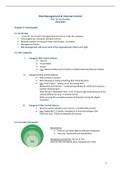Samenvatting
Summary Risk Management and internal control 2022/2023
- Instelling
- Universiteit Antwerpen (UA)
This document contains a summary or overview of all the lessons (notes) and slides of the course 'Risk management and internal control', taught by Kris Hardies. At the end of each part, the quizzes are added as well (with the right answers). No guest lectures or separate cases were added, as they c...
[Meer zien]



